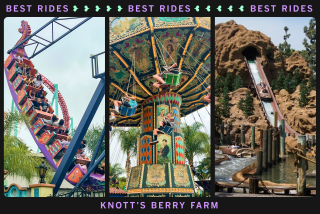A Family Hitches Its Fortunes to a Railway Car From a Bygone Era
- Share via
“Trains,” Bill wrote candidly in the Christian Singles Assn. matchmaker questionnaire, when asked to describe hobbies or interests.
No need to bother calling that one, reasoned Debbie, checking the list for possible dates.
Fortunately, he called her.
Twelve years later, Bill and Debbie Hatrick are long married with two daughters, Amanda, 10, and Cristy, 8, and a little family business centered in one long hunk of rolling stock older than all of them: a refurbished 1949 Club Lounge Railway Car.
Train buffs, history enthusiasts, and the merely curious pay $55 to sink into the peach-and-blue overstuffed banquettes and armchairs, feast on fresh asparagus and assorted snacks and watch the Pacific roll by on a round trip from Union Station to San Diego.
The geography is familiar, but the ambiance--complete with ‘40s swing music--is something few living Americans have ever experienced.
“I married into this,” Debbie laughed ruefully on a recent Saturday, gesturing from her comfortable overstuffed loveseat in the Pullman Standard. “It’s finally growing on me.”
The business, dubbed the Overland Trail, has been rolling since January on the second Saturday of the month, when the Pullman cozies up to an Amtrak engine.
Hitching up to Amtrak costs the Hatricks $1,000 for the day. Their passengers have the run of the train, but with coffee at 15 cents, soft drinks 20 cents and free snacks, plus a club-car restroom, who wants to leave the Pullman?
Four men opted during the recent San Diego-to-Los Angeles run to get a haircut. Yes, the car has its own barbershop, as rail cars did in the days when people had more time to traverse the country, attending to personal tasks along the way. While haircuts at $5 found takers, none of the men on this day were eager to risk a straight razor shave aboard the swaying car.
All the Hatricks work, although Debbie and the girls may deboard for awhile in Santa Ana, where the family lives. Debbie prepares the fresh platters of vegetables and sauces and (for the 7:15 a.m. run) muffins. Amanda is in charge of flowers for the tables. Cristy straightens the shelved racks of books and magazines on railroad lore. Both girls vacuum.
Bill Hatrick, in a ‘40s-vintage Santa Fe conductor’s cap and ‘60s-era conductor’s uniform, is everywhere--welcoming passengers aboard, punching the souvenir ticket complete with diagram and history of his rail car, hosting and chatting all along the coast. He’s the grandson of a railroad man and started riding this very Amtrak route when he was 15. He was hooked.
He signed the contract to buy the gray club car, at a bargain $20,000, just before he met Debbie. At the time, he had a perfectly lucrative job at Seal Beach Naval Weapons Station. Five years ago, defense-industry downsizing ended that, and Overland Trail became the primary breadwinning occupation of all four Hatricks.
This week the Hatricks and a few paying train buffs are in Sacramento for Railfair ’99 at the California State Railroad Museum. Their car is on display. The girls are along because Debbie home-schools them and feels she can turn the experience into an educational outing.
Always a train buff, a handy mechanic and an engineer if he gets the chance, Hatrick had helped restore private rail coaches for others. But having his own car meant nirvana--and some 12 years of sweat and more than $25,000 beyond the car’s cost.
Hatrick’s car was built by Pullman Standard Car Manufacturing Co. of Chicago for Southern Pacific Railroad. The Art Deco/Streamline Moderne lounge, originally numbered S.P. 2981, exuded state-of-the-art comfort, designed to keep first-class passengers riding the rails as America began turning to automobiles.
Shiny S.P. 2981 shuttled grandly between Oakland and Chicago through the 1950s as part of the San Francisco Overland, a train jointly operated by Southern Pacific, Union Pacific and Chicago & Northwestern. It had a brief run between Oakland and Santa Cruz before falling on hard times as trains lost passengers in droves.
Luxurious built-in furniture, tables and carpet were stripped and replaced with linoleum. The first-class lounge car became a disco dance hall on Amtrak’s Reno Fun Train, carrying gamblers from Oakland to Reno from 1966 to 1979. After that, the car passed into private hands and meandered around sidings throughout California until Hatrick bought it in Anaheim.
By then, the pride of Pullman Standard had lost all of its inner decor except the quarter-circle bar and original murals of California’s spectacular Mt. Lassen and El Capitan.
In the 1980s, however, the Pullman company still existed, so Hatrick was able to obtain photographs and specifications of what he was setting out to restore. The specs, two inches thick, told him more than anybody ever wanted to know about who manufactured the carpet, the drapes, the ashtrays, the moldings, the upholstery, the furniture. Many of those companies had gone out of business, but Hatrick could match what they had made for S.P. 2981. He cadged pieces of furniture from other abandoned Pullman cars, rebuilt, refurbished and from pieces made the whole.
His efforts have won recognition from the Modern Committee of the Los Angeles Conservancy.
“This,” he said, riding happily along in his conductor’s garb, “is really the only way to travel.”
More to Read
Sign up for The Wild
We’ll help you find the best places to hike, bike and run, as well as the perfect silent spots for meditation and yoga.
You may occasionally receive promotional content from the Los Angeles Times.






